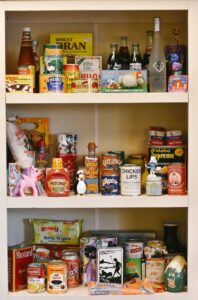COVID-19 is causing more pain than canceled events, mask acne, and virtual school. (Please know I am not minimizing life for all of you with school-aged children; I imagine it’s incredibly difficult and frustrating. I truly feel sorry for you and your kids.)
But it’s also causing hunger pains.
For many of us, shopping for groceries over the last few months has been frustrating. Toilet paper and other items couldn’t be found, stores and the government limited how many people could be in a store at a time, and directional signs and dots told us where to go and where to stand.

But for many Americans (and many more around the world) the problem was bigger. Before COVID hit, almost 37 million Americans were “food insecure,” meaning they lacked access to enough food for a healthy life at some point during the year. In fact, 1 in 7 households with children—11 million children—fit that category.*
COVID-19 closures and sickness have pushed that number higher. “As of June 2020, more than 20 percent of American households are experiencing food insecurity, according to Dr. Lauren Bauer, a Fellow in Economic Studies at the Brookings Institution.”**
Food banks and pantries are feeling the pressure. Feeding America, a network of food delivery organizations, says food banks are serving far more people this year, on average 50% more, but in some areas much greater.*** People are lining up hours early, hoping to find food to help their families survive another week, another month perhaps. And food banks are consistently running out of food.
Wherever we are, there are likely local food banks. So how can we help?
Honestly, the most practical thing we can do is donate money so the food bank can pay to meet critical needs in their stock.
But what if we want to help in a more hands-on way, maybe a way we can get our kids or grandkids involved? The first step is to check for a “needs list” on your local food bank’s website. If you don’t find a list, here’s my suggestion: think protein. Canned tuna, canned chicken, and peanut butter. Spaghetti sauce with meat. Check to see if they have cold storage, and if so what meats or cheeses they need. Then add the things that round those items out to a meal: pasta, jam, canned veggies and fruit. If you are gluten-free or vegan, consider providing options for others with similar eating restrictions.
Here’s the “staples” list from my local food bank:
- Cereal
- Oatmeal
- Canned vegetables
- Canned tuna
- Canned pork and beans
- Canned fruit
- Soup
- Apple sauce
- Boxed baking mixes
- Boxed breakfast mixes
- Pancake syrup
- Boxed side dishes
- Pasta and rice
- Macaroni and cheese
- Instant mashed potatoes
- Crackers
- Cookies
- Jell-O and pudding mixes
- Peanut butter
- Jelly
- Ketchup – condiments
- Granola bars
- Microwave popcorn
- Snacks – pretzels, chips, etc.
“WAIT!” you may be saying. “Popcorn? Potato chips? No one ‘needs’ that!” You may be right, but sometimes it’s wonderful to be able to give your kids (or yourself) a treat when life is hard. And these COVID days are hard.

The other category we often don’t think about with something called a “food bank” is personal care items, things like:
- Deodorant
- Hand soap
- Body soap
- Toothpaste
- Dish soap
- Detergent
- Toilet paper
- Paper towels
- Kleenex
And I would add, sanitary products: pads or tampons. (Imagine having to choose between buying sanitary products for yourself or food for your child.) You can also check if the food bank distributes diapers.
All of these items are expensive, and yet it’s hard to do life without them, as we all discovered during the toilet paper shortages.
These days are wearing on us all. We want life to go back to normal. But for now this is where we are. Let’s reach out and help others around us at least be able to eat, to handle a menstrual cycle, and maybe even to enjoy a treat after a particularly trying day.
As Jesus said, “‘Come, you who are blessed by my Father; take your inheritance, the kingdom prepared for you since the creation of the world. For I was hungry and you gave me something to eat. . . . Truly I tell you, whatever you did for one of the least of these brothers and sisters of mine, you did for me.” (Matthew 25:34–40)
Let’s be about feeding Jesus!
*https://www.ers.usda.gov/data-products/ag-and-food-statistics-charting-the-essentials/food-security-and-nutrition-assistance/
**https://www.forbes.com/sites/tommytobin/2020/07/08/fighting-food-insecurity-amid-covid-19/#70ac21e06862
***https://www.wsj.com/articles/pandemic-growing-need-strain-u-s-food-bank-operations-11594891802

THANK YOU, THANK YOU, THANK YOU, Carol! As manager of the food cupboard at our church, I find your advice right on the mark. I agree that it’s most important to check with them first to see what they need–and what they don’t need–instead of assuming that everyone “can always use” more canned corn and green beans. One thing I learned only after entering Food-Cupboard-Land was that our guests can’t buy even basic personal care items with SNAP (formerly called Food Stamps) because, well, they’re not food. Blessings to you!
Janet, thank you for the work you do in this capacity and for confirming the idea of asking what is most needed. May God continue to use your ministry to share his love with others.